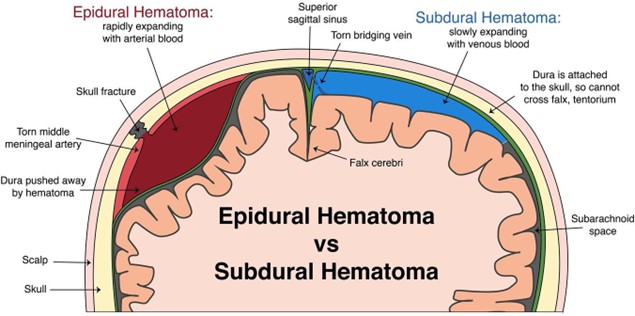A nurse in the emergency department is caring for a client who was injured in a motor-vehicle crash. The client reports dyspnea and severe pain. The nurse notes that the client's chest moves inward during inspiration and bulges out during expiration. The nurse should identify this finding as which of the following?
Pneumothorax
Atelectasis
Flail chest
Hemothorax
The Correct Answer is C
Choice A Reason: This is incorrect because a pneumothorax is a condition in which air enters the pleural space and causes the lung to collapse. It does not cause the chest wall to move inward and outward paradoxically.
Choice B Reason: This is incorrect because atelectasis is a condition in which alveoli collapse and cause reduced gas exchange. It does not cause the chest wall to move inward and outward paradoxically.
Choice C Reason: This is correct because flail chest is a condition in which multiple ribs are fractured and cause a segment of the chest wall to detach from the rest of the thoracic cage. It causes the chest wall to move inward and outward paradoxically, as well as dyspnea and pain.
Choice D Reason: This is incorrect because a hemothorax is a condition in which blood enters the pleural space and causes the lung to collapse. It does not cause the chest wall to move inward and outward paradoxically.
Nursing Test Bank
Naxlex Comprehensive Predictor Exams
Related Questions
Correct Answer is C
Explanation
Choice A Reason: Albumin 25% is not a medication that the nurse should plan to administer for a client who is experiencing Cushing's triad following a subdural hematoma. Albumin 25% is a colloid solution that increases the oncotic pressure and draws fluid from the interstitial space into the intravascular space, which can worsen the intracranial pressure by increasing the cerebral blood flow and edema.
Choice B Reason: Dextran 70 is not a medication that the nurse should plan to administer for a client who is experiencing Cushing's triad following a subdural hematoma. Dextran 70 is a plasma expander that increases the blood volume and viscosity, which can also worsen the intracranial pressure by increasing the cerebral blood flow and edema.
Choice C Reason: Mannitol 25% is a medication that the nurse should plan to administer for a client who is experiencing Cushing's triad following a subdural hematoma. Mannitol 25% is an osmotic diuretic that reduces the intracranial pressure by creating an osmotic gradient and drawing fluid from the brain tissue into the blood vessels, which can then be excreted by the kidneys. The nurse should monitor the urine output, serum osmolality, and electrolytes when administering mannitol 25%.
Choice D Reason: Hydroxyethyl starch is not a medication that the nurse should plan to administer for a client who is experiencing Cushing's triad following a subdural hematoma. Hydroxyethyl starch is another plasma expander that has similar effects as dextran 70, and can also increase the risk of coagulopathy and renal failure.

Correct Answer is ["A","C","E"]
Explanation
Choice A Reason: This choice is correct because verifying the prescribed ventilator settings daily is an important intervention to ensure that the client is receiving adequate ventilation and oxygenation. The ventilator settings include parameters such as tidal volume, respiratory rate, fraction of inspired oxygen (FiO2), positive end-expiratory pressure (PEEP), and peak inspiratory pressure (PIP). The nurse should check that the settings match the prescription and report any changes or alarms to the provider.
Choice B Reason: This choice is incorrect because applying restraints if the client becomes agitated is not a recommended intervention to prevent complications. Restraints may cause injury, infection, or psychological distress to the client and increase the risk of ventilator-associated pneumonia (VAP). The nurse should use alternative methods to manage agitation, such as sedation, analgesia, or environmental modification.
Choice C Reason: This choice is correct because administering pantoprazole as prescribed is an important intervention to prevent complications. Pantoprazole is a proton pump inhibitor (PPI) that reduces the production of stomach acid and prevents gastroesophageal reflux disease (GERD) and stress ulcers. These conditions can cause aspiration, bleeding, or infection in clients who are receiving mechanical ventilation.
Choice D Reason: This choice is incorrect because repositioning the endotracheal tube to the opposite side of the mouth daily is not a recommended intervention to prevent complications. Repositioning the endotracheal tube may cause trauma, bleeding, or displacement of the tube, which can compromise the airway and ventilation of the client. The nurse should secure the tube with tape or a device and check its position regularly using chest x-ray or end-tidal CO2 monitoring.
Choice E Reason: This choice is correct because elevating the head of the bed to at least 30° is an important intervention to prevent complications. Elevatin the head of the bed helps to reduce the risk of aspiration, which is the inhalation of gastric contents or secretions into the lungs. Aspiration can cause pneumonia, atelectasis, or respiratory failure in clients who are receiving mechanical ventilation.

Whether you are a student looking to ace your exams or a practicing nurse seeking to enhance your expertise , our nursing education contents will empower you with the confidence and competence to make a difference in the lives of patients and become a respected leader in the healthcare field.
Visit Naxlex, invest in your future and unlock endless possibilities with our unparalleled nursing education contents today
Report Wrong Answer on the Current Question
Do you disagree with the answer? If yes, what is your expected answer? Explain.
Kindly be descriptive with the issue you are facing.
